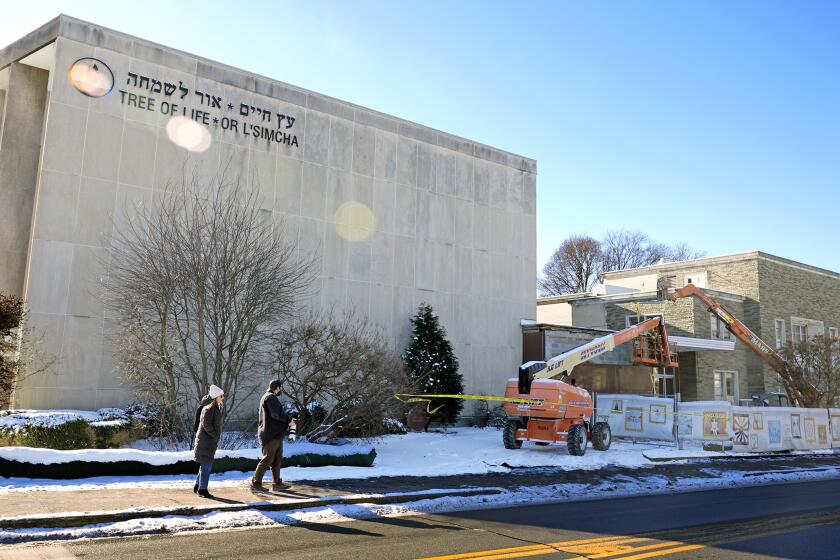County’s Unemployment Rate Stays at 5.5% : Economy: Optimism is still slow in coming despite the fact that the March figure mirrors the percentage in February.
The jobless rate in Orange County remained at 5.5% in March, the state reported Wednesday.
“The hemorrhage in job losses has stopped,” said Anil Puri, chairman of Cal State Fullerton’s economics department. “It appears the brunt of the recession is behind us.”
Eleanor Jordan, state labor market analyst for Orange County, was more cautious, however. “All in all, the numbers are encouraging, but it’s too soon to tell if things have turned around,” she said.
In February, the county’s jobless rate hit 5.5%, the highest level in eight years. The state Employment Development Department originally reported joblessness among county residents at 5.6% in February but later revised the figure.
In a separate report measuring the number of people working for Orange County businesses, the state said non-agricultural employment was up by 4,800 between February and March to 1.13 million. But compared to March, 1991, the number of non-agricultural jobs fell by 29,600, a 2.5% decline.
First-quarter averages from 1991 to 1992 show a loss of 26,000 jobs, a 2.2% decrease.
That figure is higher than economists at Chapman University in Orange had forecast: The university had predicted a 1% year-to-year loss.
Esmael Adibi, director of Chapman’s University Center for Economic Research, said the projection underestimated the number of jobs lost in manufacturing and construction. Orange County had 228,900 manufacturing jobs in March, 1992, compared to 239,500 a year earlier. Jobs in construction totaled 47,500 in March, down from 52,600 last year.
Adibi said a construction turnaround has not materialized: There is standing inventory of residential, commercial and warehouse space. And manufacturers are cutting jobs in anticipation of further decreases in defense spending.
Puri of Cal State Fullerton agreed that the number of defense-related jobs will continue to fall in the coming months, although the rate of decline has slowed. Orange County lost 500 defense jobs between February and March, 1991, he said, but in the same period this year gave up only 100 jobs.
One other bleak prediction from Puri: The worsening California deficit may cause layoffs among state employees in the next few months. Until now, employment in that sector had held steady during the recession.
On the bright side, the service sector began adding jobs in March, reporting a 0.3% gain to 853,100 compared to February’s 850,300 jobs. Economists have been watching that figure carefully because Orange County in previous recessions has not lost service jobs. In this downturn, however, the number had fallen steadily until March.
In March, 1991, the county had 866,500 jobs in the service industries, which include transportation, wholesale trade, retail trade, finance, insurance and government.
Retail employment showed a slight loss between February and March, from 194,400 jobs to 193,800. Puri said that signifies a continuing lack of consumer confidence. In March, 1991, the county had 202,400 retail jobs.
Although the recession was statistically over about a year ago--when the gross domestic product stopped declining--he said “it will be a long time before people recover psychologically.”
Service industry jobs in tourism, wholesale, retail, finance and insurance will grow during the next two quarters, Adibi predicted.
Before the riots in Los Angeles, he had forecast a large boom in tourism, with employment increasing by 5% from now until year’s end. But the disturbances have caused him to scale back that projection somewhat. Still, he is optimistic that Orange County will have many visitors this year.
“Domestically, people know Orange County is far from Los Angeles,” he said. In fact, “people who were planning to visit Los Angeles may come to Orange County or San Diego instead.”
O.C.’s Employment Picture Although the jobless rate in March remained at 5.5% for the second consecutive month, Orange County’s unemployment is the lowest in Southern California and below statewide and national rates.
How Counties Compare Orange County’s jobless rate is nearly half that of Riverside and San Bernardino counties, which have the highest rates in Southern California.
California: 8.5% United States: 7.3 Riverside/San Bernardino: 9.8 Los Angeles: 9.0 Santa Barbara: 7.7 Ventura: 7.0 San Diego: 6.6 Orange: 5.5
March Unemployment The 5.5% unemployment rate is the third highest in Orange County in a decade, topped only by 8.1% for March, 1983, and 6.2% for March, 1982. March, 1992: 5.5% March, 1991: 4.8 March, 1990: 2.6 March, 1989: 2.5 March, 1988: 2.9 March, 1987: 3.3 March, 1986: 4.2 March, 1985: 4.2 March, 1984: 5.1 March, 1983: 8.1 March, 1982: 6.2 March, 1981: 4.4
Wages Paid The service industries, which include tourism, retail and government, account for the bulk of the wages paid in the county.
Wages % of total (in millions) Agriculture $6.0 0.6% Manufacturing 151.4 13.3 High-tech 77.5 6.8 Construction, mining 48.8 4.3 Service industries 410.1 36.1 Tourism 117.1 10.3 Retail 193.8 17.0 Government 132.1 11.6
Source: California Employment Development Department .
Working in Orange County If you have a job in Orange County, chances are 8 in 10 that you receive your wages or salary from a private employer. that is slightly higher than the statewide proportaion of 3 in 4 in the private sector. More of the county’s pool of women 16 and older are in the labor force.
Private Sector Employs Most The percentage of workers privately employed increased about one percentage point from 1980 to 1990. The percentage of government workers dipped 2% to 1 in 10.
Private wage / salary: 81.3% Government: 10.3%Self-employed: 8.0% Unpaid family worker: 0.4%
More Women Working Mirroring a statewide trend, a greater percentage of women 16 years and older were workingin 1990 than in 1980, while the percentage of ment working remained the same.
Women 1980: 56.8% 1990: 62.8% Men 1980: 82.6% 1990: 82.5%
Employment by Industry Although manufacturing still employs the largest percentage of the work force, it suffered declines in both the durable and non-durable sectors during the 1980s.
1980 1990 Change Misc. professional, related services 4.4% 6.7% 2.3% Entertainment, recreation 0.0 1.8 1.8 Finance, insurance, real estate 7.9 9.1 1.2 Business, repair service 5.5 6.2 0.7 Wholesale 4.9 5.4 0.5 Construction 6.4 6.8 0.4 Health 6.0 6.5 0.5 Mining 0.0 0.1 0.1 Agriculture 1.7 1.8 0.1 Transportation 3.4 3.4 0.0 Communication, public utilities 2.1 1.9 -0.2 Manufacturing, non-durable goods 6.0 5.7 -0.3 Public administration 3.1 2.7 -0.4 Personal services 4.3 3.6 -0.7 Education 7.0 6.3 -0.7 Retail 17.4 16.2 -1.2 Manufacturing, durable goods 19.9 15.7 -4.2
Source: U.S. Census Bureau
More to Read
Start your day right
Sign up for Essential California for news, features and recommendations from the L.A. Times and beyond in your inbox six days a week.
You may occasionally receive promotional content from the Los Angeles Times.






